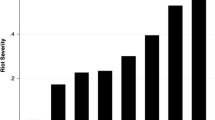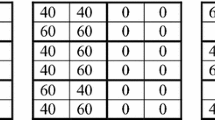Abstract
In this note, we use a consistently defined set of metropolitan areas to study patterns and trends in black hypersegregation from 1970 to 2010. Over this 40-year period, 52 metropolitan areas were characterized by hypersegregation at one point or another, although not all at the same time. Over the period, the number of hypersegregated metropolitan areas declined by about one-half, but the degree of segregation within those areas characterized by hypersegregation changed very little. As of 2010, roughly one-third of all black metropolitan residents lived in a hypersegregated area.



Similar content being viewed by others
References
Denton, N. A. (1994). Are African Americans still hypersegregated? In R. D. Bullard, J. E. Grigsby, III, & C. Lee (Eds.), Residential apartheid: The American legacy (pp. 49–81). Los Angeles, CA: CAAS Publications, University of California.
Duncan, O. D., Cuzzort, R. P., & Duncan, B. (1961). Statistical geography: Problems in analyzing areal data. New York, NY: Free Press.
Duncan, O. D., & Duncan, B. (1955). A methodological analysis of segregation indices. American Sociological Review, 20, 210–217.
Hartman, C., & Squires, G. D. (Eds.). (2013). From foreclosure to fair lending: Advocacy, organizing, occupy, and the pursuit of equitable credit. New York, NY: New Village Press.
Jargowsky, P. A. (1997). Poverty and place: Ghettos, barrios, and the American city. New York, NY: Russell Sage Foundation.
Kochhar, R., Fry, R., & Taylor, P. (2011). Twenty-to-one: Wealth gaps rise to record highs between whites, blacks and Hispanics. Washington, DC: Pew Research Center.
Lieberson, S. (1981). An asymmetrical approach to segregation. In C. Peach, V. Robinson, & S. Smith (Eds.), Ethnic segregation in cities (pp. 61–82). London, UK: Croom Helm.
Logan, J. R., & Stults, B. J. (2011). The persistence of segregation in the metropolis: New findings from the 2010 census (Census brief prepared for Project US2010). Retrieved from http://www.s4.brown.edu/us2010/Data0Report/report2.pdf
Massey, D. S. (1990). American apartheid: Segregation and the making of the underclass. American Journal of Sociology, 95, 1153–1188.
Massey, D. S., & Brodmann, S. (2014). Spheres of influence: The social ecology of racial and class inequality. New York, NY: Russell Sage Foundation.
Massey, D. S., & Denton, N. A. (1988). The dimensions of residential segregation. Social Forces, 67, 281–315.
Massey, D. S., & Denton, N. A. (1989). Hypersegregation in U.S. metropolitan areas: Black and Hispanic segregation along five dimensions. Demography, 26, 373–393.
Massey, D. S., & Denton, N. A. (1993). American apartheid: Segregation and the making of the underclass. Cambridge, MA: Harvard University Press.
Massey, D. S., & Fischer, M. J. (2000). How segregation concentrates poverty. Ethnic and Racial Studies, 23, 670–691.
Peterson, R. D., & Krivo, L. J. (2010). Divergent social worlds: Neighborhood crime and the racial-spatial divide. New York, NY: Russell Sage Foundation.
Pettigrew, T. (1979). Racial change and social policy. Annals of the American Academy of Political and Social Science, 441, 114–131.
Quillian, L. (2012). Segregation and poverty concentration: The role of three segregations. American Sociological Review, 77, 354–379.
Rugh, J. S., Albright, L., & Massey, D. S. (Forthcoming). Race, space, and cumulative disadvantage: A case study of the subprime lending collapse. Social Problems.
Rugh, J. S., & Massey, D. S. (2010). Racial segregation and the American foreclosure crisis. American Sociological Review, 75, 629–651.
Sampson, R. J. (2012). Great American city: Chicago and the enduring neighborhood effect. Chicago, IL: University of Chicago Press.
Sharkey, P. (2013). Stuck in place: Urban neighborhoods and the end of progress toward racial equality. Chicago, IL: University of Chicago Press.
Small, M. (2004). Villa Victoria: The transformation of social capital in a Boston barrio. Chicago, IL: University of Chicago Press.
White, M. J. (1983). The measurement of spatial segregation. American Journal of Sociology, 88, 1008–1019.
Wilkes, R., & Iceland, J. (2004). Hypersegregation in the twenty-first century: An update and analysis. Demography, 41, 23–36.
Wilson, W. J. (1987). The truly disadvantaged: The inner city, the underclass, and urban policy. Chicago, IL: University of Chicago Press.
Acknowledgments
The authors thank Jacob Rugh for sharing his data and saving us time and effort.
Author information
Authors and Affiliations
Corresponding author
Rights and permissions
About this article
Cite this article
Massey, D.S., Tannen, J. A Research Note on Trends in Black Hypersegregation. Demography 52, 1025–1034 (2015). https://doi.org/10.1007/s13524-015-0381-6
Published:
Issue Date:
DOI: https://doi.org/10.1007/s13524-015-0381-6




